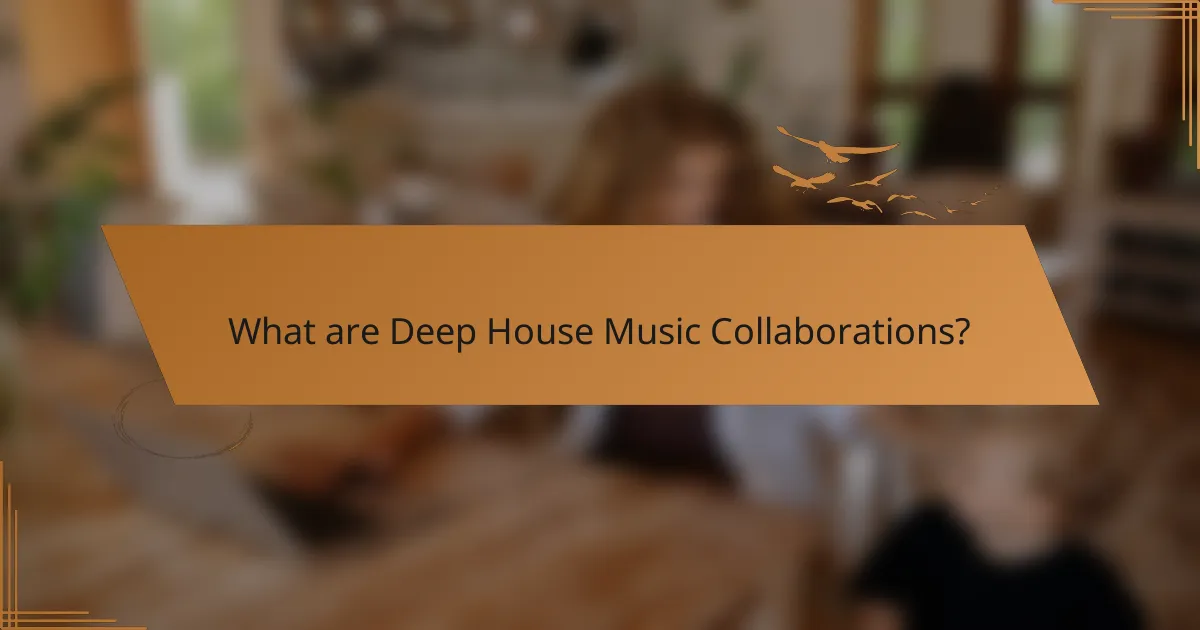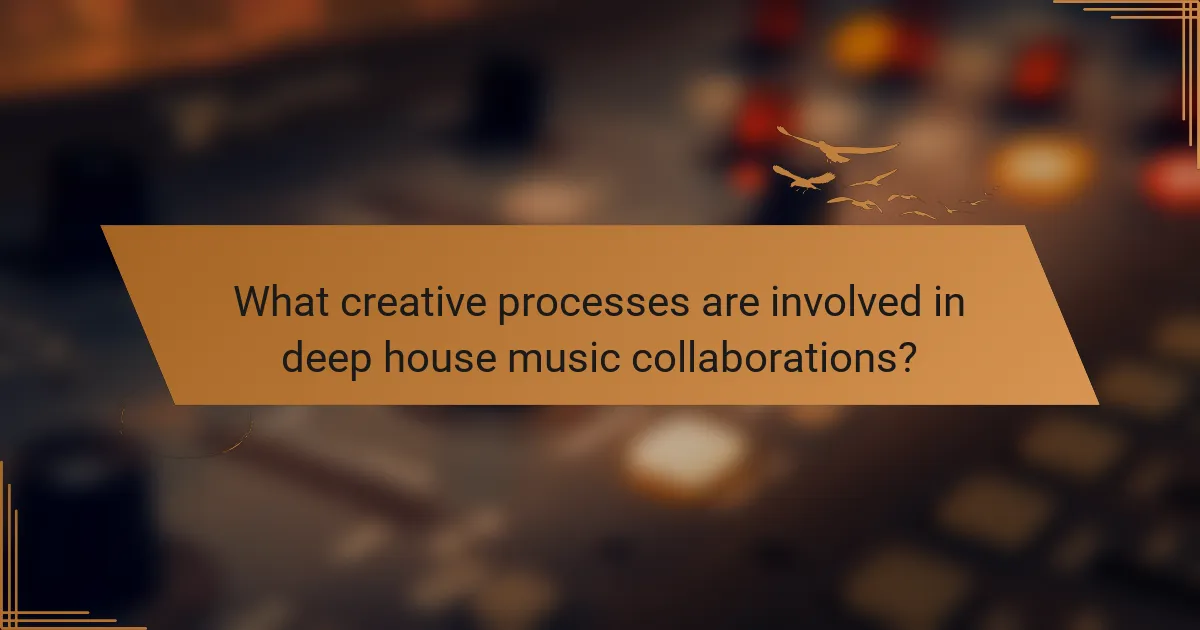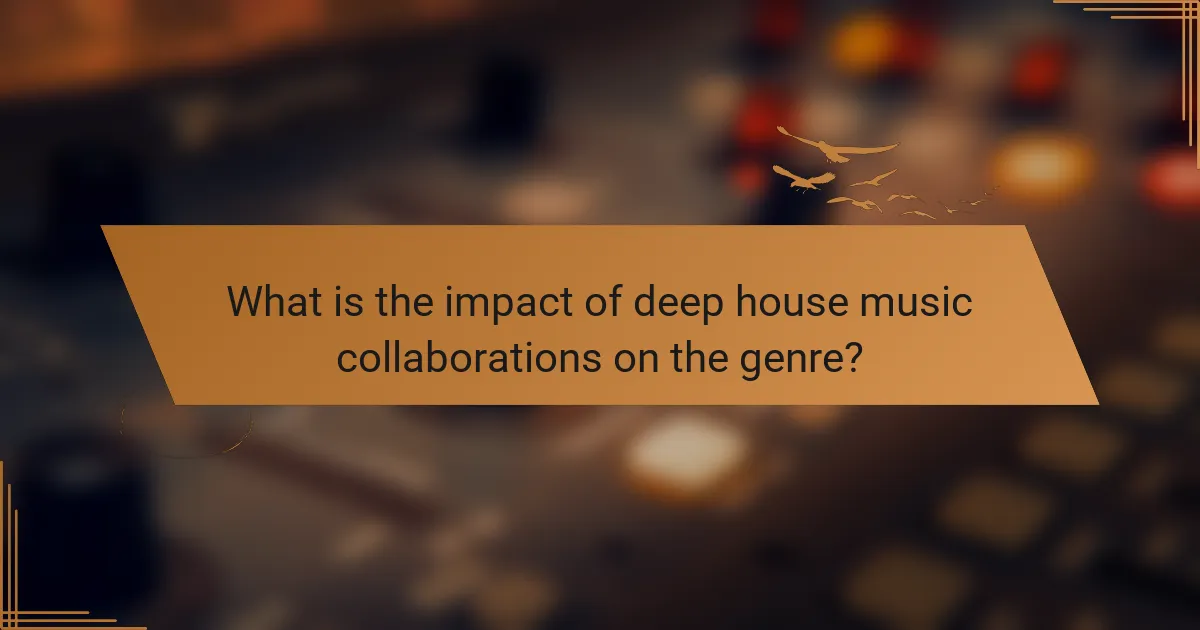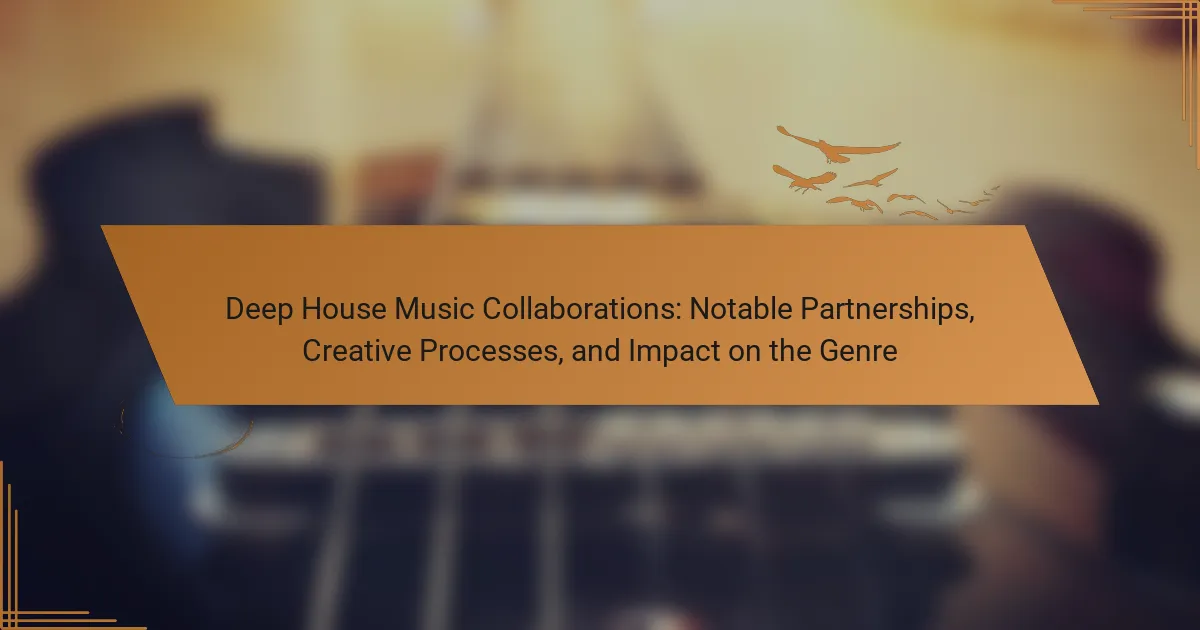Deep House Music Collaborations are partnerships among artists, including producers, vocalists, and instrumentalists, aimed at creating innovative deep house tracks. These collaborations enhance creativity and broaden audience reach by merging unique styles and influences, often resulting in genre-defining sounds. The article explores the creative processes involved in these partnerships, such as brainstorming, sound selection, and arrangement, highlighting the iterative feedback loops that refine the music. Notable collaborations, like those between established and emerging artists, illustrate the impact on deep house music’s diversity and innovation, showcasing how these partnerships lead to chart-topping hits and inspire new artistic directions.

What are Deep House Music Collaborations?
Deep House Music Collaborations are partnerships between artists to create deep house tracks. These collaborations often involve producers, vocalists, and instrumentalists. Artists combine their unique styles and influences to produce innovative sounds. Collaborations can enhance creativity and broaden the audience reach. Notable collaborations include those between established and emerging artists. They often result in tracks that push genre boundaries. This collaborative approach contributes to the evolution of deep house music.
How have collaborations shaped the deep house music genre?
Collaborations have significantly shaped the deep house music genre by blending diverse musical influences. Artists from various backgrounds bring unique styles and techniques. This fusion results in innovative sounds that push genre boundaries. Notable partnerships, such as those between producers and vocalists, enhance emotional depth in tracks. Collaborations often lead to cross-genre experimentation, attracting wider audiences. The 2010s saw many successful collaborations, like those involving Disclosure and Sam Smith. These partnerships have generated chart-topping hits, solidifying deep house’s mainstream presence. Overall, collaborations have been crucial in evolving deep house music and expanding its appeal.
What are the key characteristics of deep house music collaborations?
Deep house music collaborations are characterized by a blend of distinct musical styles and influences. These collaborations often involve artists from various genres, creating a rich and diverse sound. The use of soulful vocals is a common feature, enhancing emotional depth in the tracks. Collaborations frequently showcase intricate production techniques, including layering and sampling. The integration of live instrumentation is also prevalent, adding a unique texture to the music. Additionally, deep house collaborations emphasize a strong rhythmic foundation, often featuring deep basslines and steady beats. These partnerships can result in innovative tracks that push the boundaries of the genre, reflecting the evolving nature of deep house music.
How do collaborations influence the sound and style of deep house music?
Collaborations significantly influence the sound and style of deep house music. They bring together diverse musical backgrounds and techniques. This fusion results in unique sounds that push genre boundaries. Collaborators often share creative ideas that lead to innovative production methods. For example, a vocalist may introduce new lyrical themes. A producer might incorporate different instrumental elements. This exchange enhances the overall depth and richness of the music. Furthermore, collaborations can attract wider audiences through the combined fan bases of the artists involved. Historical examples include the partnership of artists like Disclosure and Sam Smith, which produced chart-topping hits. Such collaborations showcase how blending styles can redefine the deep house genre.
Who are some notable artists in deep house music collaborations?
Notable artists in deep house music collaborations include Disclosure, Jamie Jones, and Black Coffee. Disclosure is known for their hit tracks that blend deep house with pop elements. Jamie Jones has made significant contributions to the genre with his unique sound. Black Coffee is celebrated for his soulful deep house productions and collaborations with various artists. Other notable mentions are MK, who has worked with many vocalists, and Nora En Pure, recognized for her melodic style. Each of these artists has influenced the deep house scene through their innovative collaborations.
What partnerships have had the most significant impact on the genre?
The partnerships that have had the most significant impact on deep house music include those between established producers and vocalists. Notable collaborations, such as those between Frankie Knuckles and Jamie Principle, helped define the sound of deep house in the 1980s. The collaboration between Larry Heard and Mr. White produced iconic tracks that shaped the genre’s direction. Additionally, the partnership of Disclosure with Sam Smith brought deep house into mainstream music, expanding its audience. These collaborations often blend unique styles, enhancing the genre’s diversity. The influence of these partnerships is evident in the evolution of deep house music over the years.
How do these artists contribute to the evolution of deep house music?
These artists contribute to the evolution of deep house music by introducing innovative sounds and techniques. They blend various genres, enhancing the depth and complexity of the music. Collaborations often lead to unique fusions, pushing creative boundaries. For instance, artists like Disclosure and Jamie Jones have incorporated elements from techno and R&B. This cross-pollination results in fresh, diverse tracks that resonate with wider audiences. Additionally, their use of advanced production techniques sets new standards in sound quality. The impact of these contributions is evident in the genre’s growing popularity and its influence on mainstream music.

What creative processes are involved in deep house music collaborations?
Deep house music collaborations involve several creative processes. These processes include brainstorming sessions between artists. Producers often share ideas and concepts to develop a track’s direction. Sound selection is critical, where collaborators choose specific instruments and samples. Arrangement of the music is done collectively, determining the structure of the track.
Vocalists may contribute lyrics and melodies, adding a personal touch. Mixing and mastering are collaborative efforts to ensure sound quality. Feedback loops are established, where artists critique and refine each other’s work. This iterative process enhances creativity and leads to innovative outcomes.
How do artists typically collaborate in the studio?
Artists typically collaborate in the studio by sharing ideas and resources. They often work together on songwriting and production. This collaboration can involve one artist providing vocals while another handles instrumentation. Communication is key during these sessions. Artists may conduct brainstorming sessions to explore concepts. They often use digital audio workstations for seamless integration of their contributions. Feedback loops are common, allowing for adjustments and refinements. Collaborations can lead to innovative sounds and styles, enriching the deep house genre. Notable partnerships have historically resulted in chart-topping hits, demonstrating the power of collaborative creativity.
What tools and technologies are commonly used during these collaborations?
Digital audio workstations (DAWs) are commonly used tools in deep house music collaborations. Popular DAWs include Ableton Live, FL Studio, and Logic Pro. These platforms facilitate music production, arrangement, and mixing. Collaborators often use plugins and virtual instruments within these DAWs. Tools like Serum and Massive are frequently utilized for sound design. Communication technologies such as Zoom or Slack support remote collaboration. File-sharing services like Dropbox or Google Drive enable easy access to project files. These tools enhance creativity and streamline the collaborative process in deep house music.
How do artists overcome creative differences in the studio?
Artists overcome creative differences in the studio through open communication and compromise. They discuss their ideas and perspectives to find common ground. Active listening fosters understanding among collaborators. Setting clear goals helps align their creative visions. Utilizing brainstorming sessions encourages diverse input and collaboration. Establishing a structured workflow can minimize conflicts. Flexibility in adapting ideas is crucial for harmony. Many successful collaborations highlight the importance of these strategies in achieving a cohesive final product.
What role does improvisation play in deep house music collaborations?
Improvisation plays a crucial role in deep house music collaborations. It allows artists to express their creativity spontaneously during the production process. This spontaneity often leads to unique sounds and unexpected musical elements. Collaborators can build on each other’s ideas in real-time. This dynamic interaction enhances the overall quality of the music. Additionally, improvisation fosters a sense of connection among artists. It encourages experimentation with rhythm and melody. Many successful deep house tracks have emerged from improvisational sessions. This approach contributes to the genre’s evolving nature and diversity.
How do spontaneous decisions shape the final product?
Spontaneous decisions significantly influence the final product in deep house music collaborations. These decisions can lead to unexpected creative directions. They often result in unique soundscapes that differentiate a track. Collaborators may experiment with unplanned elements, such as unexpected beats or melodies. This spontaneity can enhance emotional depth in the music. For instance, a last-minute vocal addition might resonate with listeners more than planned elements. Historical examples show that iconic tracks often emerged from spontaneous moments. Such decisions can ultimately redefine the genre’s boundaries and appeal.
What are some examples of successful improvisation in deep house tracks?
Successful improvisation in deep house tracks can be seen in works by artists like Moodymann and Larry Heard. Moodymann often incorporates live instrumentation and spontaneous vocal elements. This creates a unique sound that evolves during performances. Larry Heard is known for his ability to blend jazz influences with deep house. His tracks often feature improvised keyboard solos that enhance the overall atmosphere.
Another example is the collaboration between Disclosure and Sam Smith. Their track “Latch” showcases improvised vocal runs that add emotional depth. Similarly, the duo Soul Clap often improvises during live sets, creating a dynamic experience. These instances highlight how improvisation can enhance creativity in deep house music.

What is the impact of deep house music collaborations on the genre?
Deep house music collaborations significantly enhance the genre’s diversity and innovation. These partnerships often blend different musical styles and influences. For example, collaborations between deep house artists and vocalists can create unique soundscapes. This fusion attracts a broader audience and encourages cross-genre experimentation. Notable collaborations, like those involving artists such as Disclosure and Sam Smith, showcase this impact. Such partnerships often lead to chart-topping hits, which elevate the genre’s visibility. Additionally, collaborations can inspire emerging artists to explore new creative avenues. This dynamic interplay ultimately drives the evolution of deep house music.
How do collaborations affect the popularity of deep house music?
Collaborations significantly enhance the popularity of deep house music. They bring together diverse talents, attracting fans from different genres. This cross-pollination increases exposure and broadens the audience base. Notable partnerships often lead to chart-topping tracks, which further boosts visibility. For example, collaborations between established artists and emerging talents create buzz and generate interest. Additionally, joint performances at festivals can amplify reach and engagement. The fusion of styles in collaborations often results in innovative sounds that captivate listeners. Overall, collaborations are a powerful tool in driving the popularity of deep house music.
What trends have emerged from successful collaborations?
Successful collaborations in deep house music have led to several notable trends. One trend is the blending of diverse musical styles. Artists increasingly incorporate elements from genres like jazz, funk, and techno. This fusion creates unique sounds that appeal to broader audiences. Another trend is the rise of virtual collaborations. Technology enables artists to work together remotely, expanding creative possibilities. Additionally, there is a focus on community-driven projects. Collaborations often involve multiple artists, fostering a sense of unity within the genre. Data shows that tracks resulting from such partnerships frequently achieve higher chart placements. This indicates that successful collaborations enhance commercial viability. Overall, these trends reflect an evolving landscape in deep house music.
How do collaborations expand the audience for deep house music?
Collaborations expand the audience for deep house music by merging fan bases of different artists. When artists from various genres collaborate, they attract listeners who may not typically engage with deep house. This cross-pollination introduces new audiences to the genre. Collaborations often result in innovative sounds that appeal to a broader demographic. For example, a deep house artist teaming up with a pop vocalist can create a track that resonates with pop fans. This strategy increases visibility through shared marketing efforts and promotional activities. Moreover, collaborations can leverage the social media presence of all involved, amplifying reach. The result is a more diverse audience engaging with deep house music.
What are the long-term effects of collaborations on artists’ careers?
Collaborations can significantly enhance artists’ careers over the long term. They often lead to increased exposure and access to new audiences. This exposure can result in higher album sales and streaming numbers. Collaborations also allow artists to blend styles and innovate creatively. Such innovation can attract critical acclaim and awards. Additionally, successful partnerships can lead to future collaborations, creating a network effect. For example, artists like Disclosure and Sam Smith gained widespread recognition through their collaboration on “Latch.” This collaboration boosted their careers and expanded their fan base. Overall, collaborations can be a catalyst for sustained growth in an artist’s career.
How do collaborations influence an artist’s future projects?
Collaborations significantly influence an artist’s future projects by expanding their creative horizons and audience reach. When artists collaborate, they often blend different styles and techniques, leading to innovative sounds. This fusion can inspire new directions for their subsequent work. Collaborations also introduce artists to each other’s fan bases, increasing exposure. For instance, a collaboration between two popular deep house artists can result in a track that garners attention from both sets of fans. Additionally, working with other musicians can provide valuable networking opportunities. These connections may lead to future collaborations or joint projects. Overall, collaborations can shape an artist’s evolution and career trajectory in profound ways.
What opportunities arise from successful deep house music partnerships?
Successful deep house music partnerships create opportunities for increased exposure and audience reach. Collaborations often combine fan bases, leading to greater visibility for all artists involved. These partnerships can result in innovative sound development, pushing the genre’s boundaries. Financial benefits also arise through shared resources and joint marketing efforts. Successful collaborations can lead to performances at larger venues and festivals, enhancing live experience opportunities. Moreover, they can facilitate access to industry networks, opening doors for future projects. Statistics show that collaborative tracks often perform better on streaming platforms, indicating a higher likelihood of commercial success.
What best practices should artists follow when collaborating in deep house music?
Artists should prioritize clear communication when collaborating in deep house music. This ensures that all parties understand their roles and expectations. Setting shared goals enhances the creative process. Regular check-ins help maintain alignment throughout the project. Artists should be open to feedback, as constructive criticism can improve the final product. Respecting each other’s artistic vision fosters a collaborative spirit. Utilizing digital collaboration tools can streamline the sharing of ideas and files. Lastly, establishing a fair agreement on credits and royalties protects all contributors’ interests.
Deep House Music Collaborations are partnerships between artists aimed at creating innovative deep house tracks by blending diverse musical styles and influences. This article explores how collaborations have shaped the deep house genre, highlighting key characteristics, notable artists, and impactful partnerships that have defined its evolution. It also delves into the creative processes involved in these collaborations, the tools used, and the long-term effects on artists’ careers. Additionally, the article discusses how collaborations expand the audience for deep house music and the best practices artists should follow to ensure successful partnerships.
